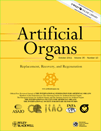Computational Fluid Dynamics-Based Hydraulic and Hemolytic Analyses of a Novel Left Ventricular Assist Blood Pump
Abstract
The advent of various technologies has allowed mechanical blood pumps to become more reliable and versatile in recent decades. In our study group, a novel structure of axial flow blood pump was developed for assisting the left ventricle. The design point of the left ventricular assist blood pump 25 (LAP-25) was chosen at 4 Lpm with 100 mm Hg according to our clinical practice. Computational fluid dynamics was used to design and analyze the performance of the LAP-25. In order to obtain a required hydraulic performance and a satisfactory hemolytic property in the LAP-25 of a smaller size, a novel structure was developed including an integrated shroud impeller, a streamlined impeller hub, and main impeller blades with splitter blades; furthermore, tandem cascades were introduced in designing the diffuser. The results of numerical simulation show the LAP-25 can generate flow rates of 3–5 Lpm at rotational speeds of 8500–10 500 rpm, producing pressure rises of 27.5–148.3 mm Hg with hydraulic efficiency points ranging from 13.4 to 27.5%. Moreover, the fluid field and the hemolytic property of the LAP-25 were estimated, and the mean hemolysis index of the pump was 0.0895% with Heuser's estimated model. In conclusion, the design of the LAP-25 shows an acceptable result.




